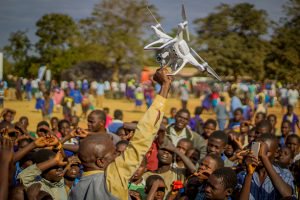UNICEF
Malawi and UNICEF have joined forces to open up a 25-mile-radius drone hall over the nation’s Kasungu Aerodrome in an effort to enhance emergency rescue operations and additional aerial analysis.
The UN company says the drone hall is the primary in Africa and will likely be utilized by universities and some personal sector enterprise along with public-safety businesses.
“Malawi has over the years proved to be a leader in innovation and it is this openness to innovation that has led to the establishment of Africa’s first drones testing corridor here in Malawi,” stated Malawi’s Minister of Transport and Public Works Jappie Mhango in a press launch. “We have already used drones as part of our flood response and we can see the potential for further uses, such as transportation of medical supplies, which could transform lives in remote rural communities.”
Dubbed the Humanitarian UAV Testing Corridor, the mission will take a look at new aerial imaging expertise, particularly throughout emergencies and will even give attention to catastrophe monitoring. Researchers hope to experiment with drone-based Wi-Fi and cell connectivity for distant areas.
“This humanitarian drone testing corridor can significantly improve our efficiency and ability to deliver services to the world’s most vulnerable children,” stated UNICEF Office of Global Innovation Principal Adviser Christopher Fabian. “The success of these trials will depend on working in new ways with the private sector, government and local entrepreneurs and engineers who can ensure that technologies deliver appropriate solutions for the people who need them the most.”
In accordance with Malawi Department of Civil Aviation laws, the drones could not journey greater than 50 miles from the aerodrome and no larger than 1,300 toes. The program will expire in two years.
Malawi is one in all a number of African nations innovating with drone expertise. Rwanda has already created plans for the world’s first drone port, and launched a mannequin for drone supply of medical provides. In February, drone mapping agency Pix4D introduced a partnership with Rwandan faculties to coach specialists in UAV photogrammetry.
Last 12 months, Tanzania’s Ministry of Tourism accepted the usage of drone patrols over Tarangire National Park to cease poachers. Park law-enforcement makes use of Super Bat DA 50 fixed-wing drones by Martin UAV. The fixed-wing plane has a 15,000 flight ceiling and can cowl a 6-10 mile radius with a gasoline vary of 450 miles.
 Unmanned Aerial Vehicle The latest drone news
Unmanned Aerial Vehicle The latest drone news




